Nick Barnes
FreeVPS: Repurposing Training-Free SAM2 for Generalizable Video Polyp Segmentation
Aug 27, 2025Abstract:Existing video polyp segmentation (VPS) paradigms usually struggle to balance between spatiotemporal modeling and domain generalization, limiting their applicability in real clinical scenarios. To embrace this challenge, we recast the VPS task as a track-by-detect paradigm that leverages the spatial contexts captured by the image polyp segmentation (IPS) model while integrating the temporal modeling capabilities of segment anything model 2 (SAM2). However, during long-term polyp tracking in colonoscopy videos, SAM2 suffers from error accumulation, resulting in a snowball effect that compromises segmentation stability. We mitigate this issue by repurposing SAM2 as a video polyp segmenter with two training-free modules. In particular, the intra-association filtering module eliminates spatial inaccuracies originating from the detecting stage, reducing false positives. The inter-association refinement module adaptively updates the memory bank to prevent error propagation over time, enhancing temporal coherence. Both modules work synergistically to stabilize SAM2, achieving cutting-edge performance in both in-domain and out-of-domain scenarios. Furthermore, we demonstrate the robust tracking capabilities of FreeVPS in long-untrimmed colonoscopy videos, underscoring its potential reliable clinical analysis.
NoiseSDF2NoiseSDF: Learning Clean Neural Fields from Noisy Supervision
Jul 18, 2025Abstract:Reconstructing accurate implicit surface representations from point clouds remains a challenging task, particularly when data is captured using low-quality scanning devices. These point clouds often contain substantial noise, leading to inaccurate surface reconstructions. Inspired by the Noise2Noise paradigm for 2D images, we introduce NoiseSDF2NoiseSDF, a novel method designed to extend this concept to 3D neural fields. Our approach enables learning clean neural SDFs directly from noisy point clouds through noisy supervision by minimizing the MSE loss between noisy SDF representations, allowing the network to implicitly denoise and refine surface estimations. We evaluate the effectiveness of NoiseSDF2NoiseSDF on benchmarks, including the ShapeNet, ABC, Famous, and Real datasets. Experimental results demonstrate that our framework significantly improves surface reconstruction quality from noisy inputs.
Open Set Label Shift with Test Time Out-of-Distribution Reference
May 09, 2025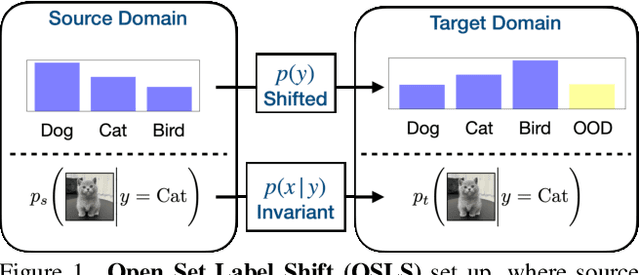
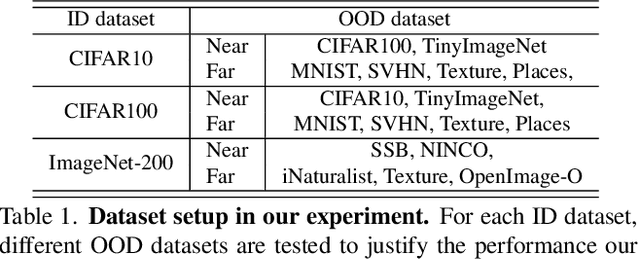


Abstract:Open set label shift (OSLS) occurs when label distributions change from a source to a target distribution, and the target distribution has an additional out-of-distribution (OOD) class. In this work, we build estimators for both source and target open set label distributions using a source domain in-distribution (ID) classifier and an ID/OOD classifier. With reasonable assumptions on the ID/OOD classifier, the estimators are assembled into a sequence of three stages: 1) an estimate of the source label distribution of the OOD class, 2) an EM algorithm for Maximum Likelihood estimates (MLE) of the target label distribution, and 3) an estimate of the target label distribution of OOD class under relaxed assumptions on the OOD classifier. The sampling errors of estimates in 1) and 3) are quantified with a concentration inequality. The estimation result allows us to correct the ID classifier trained on the source distribution to the target distribution without retraining. Experiments on a variety of open set label shift settings demonstrate the effectiveness of our model. Our code is available at https://github.com/ChangkunYe/OpenSetLabelShift.
NumGrad-Pull: Numerical Gradient Guided Tri-plane Representation for Surface Reconstruction from Point Clouds
Nov 26, 2024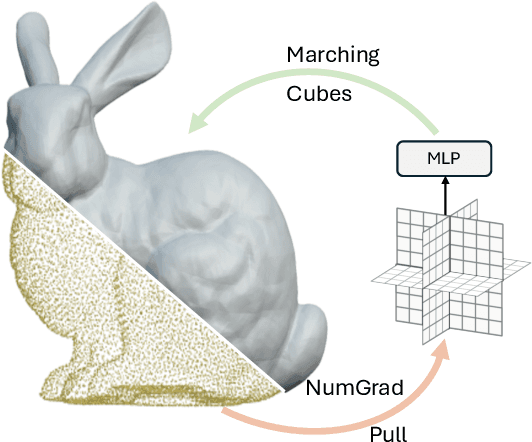

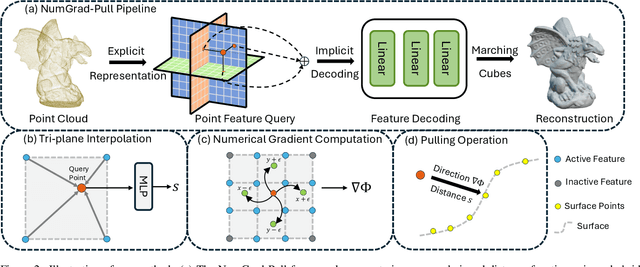

Abstract:Reconstructing continuous surfaces from unoriented and unordered 3D points is a fundamental challenge in computer vision and graphics. Recent advancements address this problem by training neural signed distance functions to pull 3D location queries to their closest points on a surface, following the predicted signed distances and the analytical gradients computed by the network. In this paper, we introduce NumGrad-Pull, leveraging the representation capability of tri-plane structures to accelerate the learning of signed distance functions and enhance the fidelity of local details in surface reconstruction. To further improve the training stability of grid-based tri-planes, we propose to exploit numerical gradients, replacing conventional analytical computations. Additionally, we present a progressive plane expansion strategy to facilitate faster signed distance function convergence and design a data sampling strategy to mitigate reconstruction artifacts. Our extensive experiments across a variety of benchmarks demonstrate the effectiveness and robustness of our approach. Code is available at https://github.com/CuiRuikai/NumGrad-Pull
Frontiers in Intelligent Colonoscopy
Oct 22, 2024Abstract:Colonoscopy is currently one of the most sensitive screening methods for colorectal cancer. This study investigates the frontiers of intelligent colonoscopy techniques and their prospective implications for multimodal medical applications. With this goal, we begin by assessing the current data-centric and model-centric landscapes through four tasks for colonoscopic scene perception, including classification, detection, segmentation, and vision-language understanding. This assessment enables us to identify domain-specific challenges and reveals that multimodal research in colonoscopy remains open for further exploration. To embrace the coming multimodal era, we establish three foundational initiatives: a large-scale multimodal instruction tuning dataset ColonINST, a colonoscopy-designed multimodal language model ColonGPT, and a multimodal benchmark. To facilitate ongoing monitoring of this rapidly evolving field, we provide a public website for the latest updates: https://github.com/ai4colonoscopy/IntelliScope.
SDI-Paste: Synthetic Dynamic Instance Copy-Paste for Video Instance Segmentation
Oct 16, 2024



Abstract:Data augmentation methods such as Copy-Paste have been studied as effective ways to expand training datasets while incurring minimal costs. While such methods have been extensively implemented for image level tasks, we found no scalable implementation of Copy-Paste built specifically for video tasks. In this paper, we leverage the recent growth in video fidelity of generative models to explore effective ways of incorporating synthetically generated objects into existing video datasets to artificially expand object instance pools. We first procure synthetic video sequences featuring objects that morph dynamically with time. Our carefully devised pipeline automatically segments then copy-pastes these dynamic instances across the frames of any target background video sequence. We name our video data augmentation pipeline Synthetic Dynamic Instance Copy-Paste, and test it on the complex task of Video Instance Segmentation which combines detection, segmentation and tracking of object instances across a video sequence. Extensive experiments on the popular Youtube-VIS 2021 dataset using two separate popular networks as baselines achieve strong gains of +2.9 AP (6.5%) and +2.1 AP (4.9%). We make our code and models publicly available.
LAM3D: Large Image-Point-Cloud Alignment Model for 3D Reconstruction from Single Image
May 24, 2024
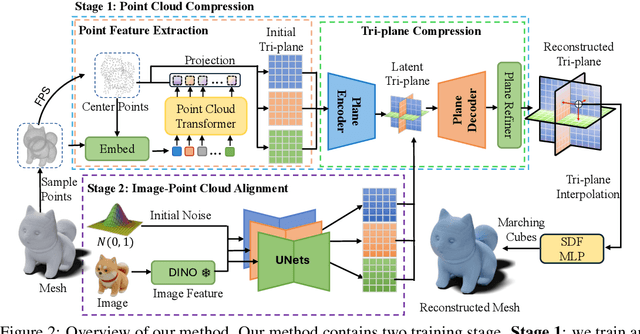
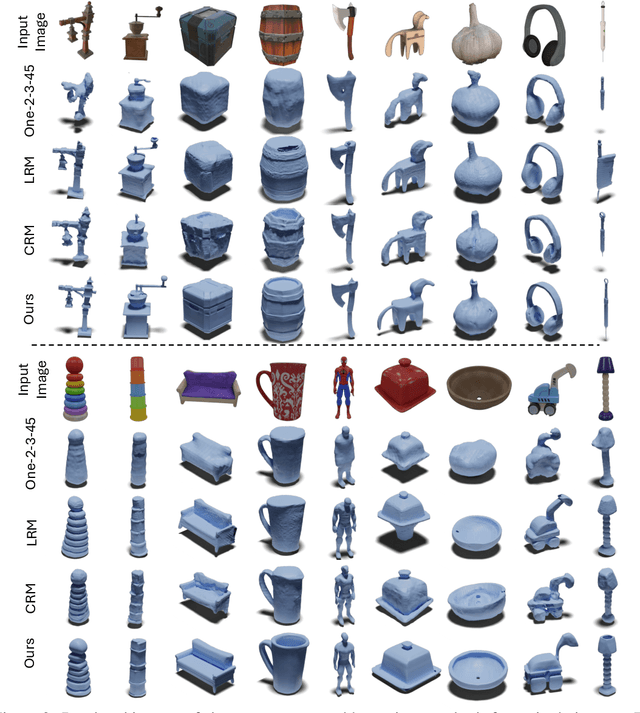

Abstract:Large Reconstruction Models have made significant strides in the realm of automated 3D content generation from single or multiple input images. Despite their success, these models often produce 3D meshes with geometric inaccuracies, stemming from the inherent challenges of deducing 3D shapes solely from image data. In this work, we introduce a novel framework, the Large Image and Point Cloud Alignment Model (LAM3D), which utilizes 3D point cloud data to enhance the fidelity of generated 3D meshes. Our methodology begins with the development of a point-cloud-based network that effectively generates precise and meaningful latent tri-planes, laying the groundwork for accurate 3D mesh reconstruction. Building upon this, our Image-Point-Cloud Feature Alignment technique processes a single input image, aligning to the latent tri-planes to imbue image features with robust 3D information. This process not only enriches the image features but also facilitates the production of high-fidelity 3D meshes without the need for multi-view input, significantly reducing geometric distortions. Our approach achieves state-of-the-art high-fidelity 3D mesh reconstruction from a single image in just 6 seconds, and experiments on various datasets demonstrate its effectiveness.
Learning Gaussian Representation for Eye Fixation Prediction
Mar 21, 2024



Abstract:Existing eye fixation prediction methods perform the mapping from input images to the corresponding dense fixation maps generated from raw fixation points. However, due to the stochastic nature of human fixation, the generated dense fixation maps may be a less-than-ideal representation of human fixation. To provide a robust fixation model, we introduce Gaussian Representation for eye fixation modeling. Specifically, we propose to model the eye fixation map as a mixture of probability distributions, namely a Gaussian Mixture Model. In this new representation, we use several Gaussian distribution components as an alternative to the provided fixation map, which makes the model more robust to the randomness of fixation. Meanwhile, we design our framework upon some lightweight backbones to achieve real-time fixation prediction. Experimental results on three public fixation prediction datasets (SALICON, MIT1003, TORONTO) demonstrate that our method is fast and effective.
Transferable Attack for Semantic Segmentation
Aug 21, 2023Abstract:We analysis performance of semantic segmentation models wrt. adversarial attacks, and observe that the adversarial examples generated from a source model fail to attack the target models. i.e The conventional attack methods, such as PGD and FGSM, do not transfer well to target models, making it necessary to study the transferable attacks, especially transferable attacks for semantic segmentation. We find two main factors to achieve transferable attack. Firstly, the attack should come with effective data augmentation and translation-invariant features to deal with unseen models. Secondly, stabilized optimization strategies are needed to find the optimal attack direction. Based on the above observations, we propose an ensemble attack for semantic segmentation to achieve more effective attacks with higher transferability. The source code and experimental results are publicly available via our project page: https://github.com/anucvers/TASS.
All-pairs Consistency Learning for Weakly Supervised Semantic Segmentation
Aug 08, 2023



Abstract:In this work, we propose a new transformer-based regularization to better localize objects for Weakly supervised semantic segmentation (WSSS). In image-level WSSS, Class Activation Map (CAM) is adopted to generate object localization as pseudo segmentation labels. To address the partial activation issue of the CAMs, consistency regularization is employed to maintain activation intensity invariance across various image augmentations. However, such methods ignore pair-wise relations among regions within each CAM, which capture context and should also be invariant across image views. To this end, we propose a new all-pairs consistency regularization (ACR). Given a pair of augmented views, our approach regularizes the activation intensities between a pair of augmented views, while also ensuring that the affinity across regions within each view remains consistent. We adopt vision transformers as the self-attention mechanism naturally embeds pair-wise affinity. This enables us to simply regularize the distance between the attention matrices of augmented image pairs. Additionally, we introduce a novel class-wise localization method that leverages the gradients of the class token. Our method can be seamlessly integrated into existing WSSS methods using transformers without modifying the architectures. We evaluate our method on PASCAL VOC and MS COCO datasets. Our method produces noticeably better class localization maps (67.3% mIoU on PASCAL VOC train), resulting in superior WSSS performances.
 Add to Chrome
Add to Chrome Add to Firefox
Add to Firefox Add to Edge
Add to Edge